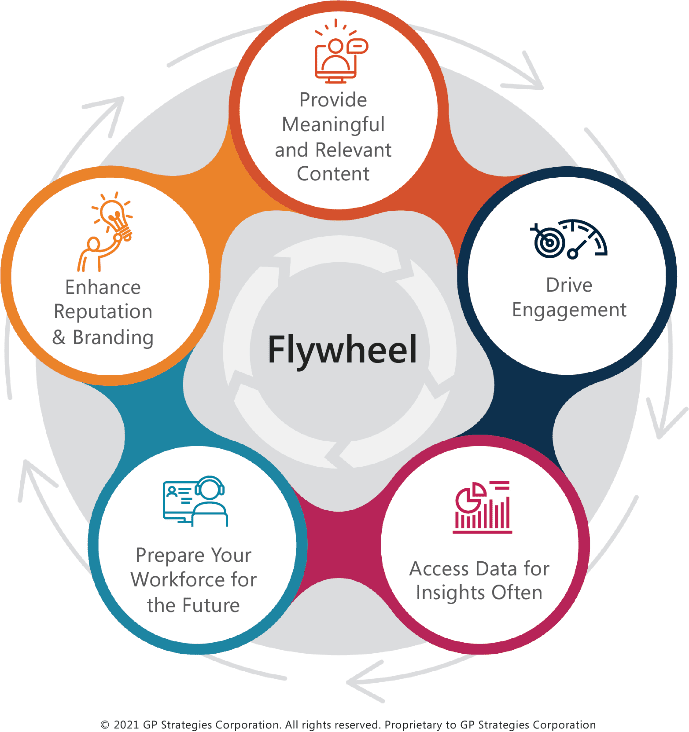Impact discussions of the baby boomer generation retiring from the workforce have been going on for a long time. This and the advancement of technology are examples of why executives have been looking to automation for product manufacturing and service capacity help within their firms.
I recently participated in a project where my client wanted to transform their workforce to remain competitive as they confronted the clash of the increasing use of technologies (e.g., artificial intelligence [AI]) to replace repetitive and mundane tasks and a shrinking labor pool.
This background set the stage for an aha moment I had along the journey. It began, as usual, with a few questions:
- How do you know if your training solution is really moving the needle for the business?
- Where do training requests originate and under what conditions?
- How do you design a sustainable impact that shows real results?
My experience is that often a business problem emerges because some business metric doesn’t meet its desired measurement threshold. This is discussed within the business. Frequently, this discussion leads to a request for a learning solution. The learning department develops a training course. Everybody is happy, right? Maybe.
My experience is that training is NOT a “field of dreams.” It is not inherently true that when you build something, people will come. Rather, my experience is that even with the best content, an entire learning and engagement ecosystem is necessary to realize training’s true value to the business.
The Flywheel Model1 is a simple way to visualize a holistic engagement strategy.
A flywheel keeps an engine turning between sparks when the fuel is ignited and force is applied to run the engine. The flywheel consists of weighted nodes that generate momentum. With each progressive application of force, the flywheel velocity increases. As with an engine, the same principles apply to learning.
Consider Amazon, a company that began with selling books. First, it focused on improving its point-of-sale (POS) systems, its inventory tracking systems, and its supply chain. After it achieved its goals and had confidence in the performance of these critical systems, it added retail. Amazon’s success in retail proved the repeatability of the model. Now, it has groceries. As it added new features and products, it applied “force” to its nodes. As a result, its flywheel spins faster and generates more revenue and market share.
Figure 1. Flywheel Model—Learning Engagement Strategy has five nodes:

At GP Strategies, we have adapted this model to more efficiently and effectively assist our clients on their learning transformation journeys.
- Provide Meaningful and Relevant Content: This node is where we provide learners access to content that builds foundational knowledge, skills, and experiences.
- Drive Engagement: This node is where we build content awareness, interest, and engagement.
- Access Data for Insights Often: We use data to gain new insights and provide the necessary information to inform evidence-based decisions.
- Prepare the Workforce for the Future: We help associates apply new learnings and insights within their work environment.
- Enhance Reputation & Branding: Our learners share with their peers the content value and they demonstrate to their business leaders how the learning impacted their performance and mindset.
Each node in our flywheel impacts each of the other nodes. For example, the Access Data for Insights Often node informs:
- The Provide Meaningful and Relevant Content node, by telling us what content is viewed most valuable as well as when content needs to be refreshed.
- The Drive Engagement node, by helping us track overall program engagement progress or, when using trackable links, which communications are most effective. Additionally, this node becomes an engagement multiplier when we apply a systematic experimentation approach that identifies best practices and informs evidence-based decisions.
- The Prepare the Workforce for the Future node, which tells when the learners effectively integrate their new knowledge and application into skills. This node also helps us know how well our training and support products are being integrated into the flow of work.
- The Enhance Reputation & Branding node helps capture qualitative comments about the content. This information can be used to determine how much internal guerrilla marketing is going on, and which business leaders are really promoting content.
My aha moment came during a discussion with several colleagues while comparing our approaches to training. My colleague’s program was organized and funded to focus only on the top node, building meaningful and relevant content, while the GP Strategies approach integrated a plan to execute the Flywheel Model.
We provide data that demonstrates not only the level of engagement with our content, but could illustrate how applying “force” to multiple nodes at the same time can result in stacked benefits. This approach has led to our ability to show the rate of acceleration over time in high fidelity, bringing lasting change and learner adoption for the organization.
Consider how your organization could benefit from a similar flywheel approach.
1 Adapted from Jim Collin’s book Turning the Flywheel, Harper Business, Feb 2019.

